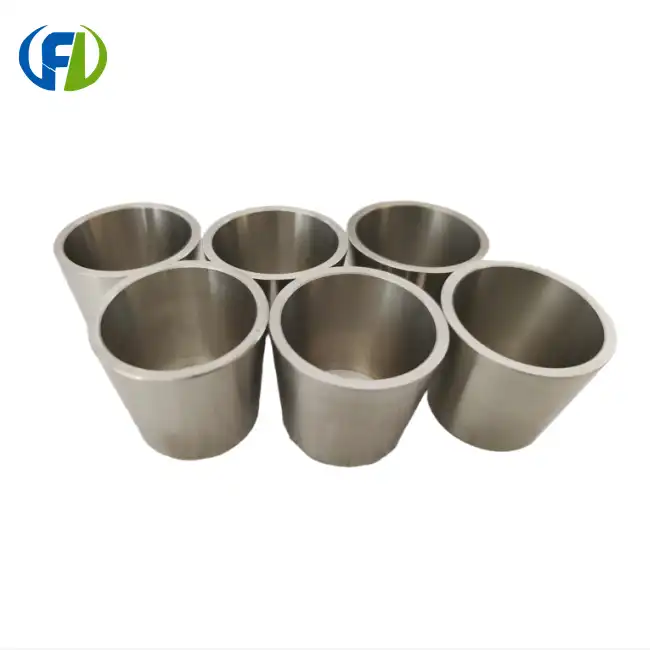Metallurgical Applications: Why are Nickel Crucibles Used for Melting Precious Metals?
As far as metallurgy goes, nickel crucibles are the best way to melt valuable metals. In this field, they are very famous because of a few key qualities that make them perfect for working with valuable materials like gold, silver, and platinum.
Superior Heat Resistance and Thermal Conductivity
Nickel has a very high melting point of about 1455°C, which means that these crucibles can handle the very high temperatures needed to melt valuable metals without breaking. This metal's resistance to heat and its high thermal conductivity make sure that the charge is heated evenly. This makes melting processes more efficient and the finished products better.
Minimal Contamination Risk
When working with valuable metals, it's very important to be pure. Because they don't react much with most precious metals, nickel crucibles are very useful in this situation. This trait makes it less likely that the valuable metals being processed will become contaminated during the melting process. This protects their purity and value.
Durability and Longevity
Nickel metals used to make crucibles are very strong, which means they last a very long time. Because these crucibles don't break down much after being heated and cooled many times, they are a good choice for long-term use in industrial processes.
Versatility in Alloy Production
Nickel crucibles are great for making specialized alloys in addition to pure valuable metals. Because they stay stable at high temperatures and don't react chemically with different metals, they are very useful for making custom alloys with exact qualities that are used in jewelry, electronics, and other high-value areas.
Chemical Processing: Are Nickel Crucibles Suitable for Handling Strong Alkalis?
Strong alkalis are especially hard to work with in the chemical processing business because they are so corrosive. In this case, nickel crucibles are the best option because they are very resistant to alkaline conditions.
Exceptional Alkali Resistance
Nickel is great for crucibles used to process strong bases because it is naturally resistant to attack by alkalis. The nickel surface forms a protective oxide layer that stops further corrosion. However, the rusting still happens. So, nickel crucibles can keep their shape even after being exposed to strong alkaline solutions for a long time.
High-Temperature Stability in Alkaline Conditions
High temperatures are needed for many chemical reactions that use strong alkalis. Nickel crucibles work great in these situations because they keep their shape and chemicals stable even in hot, acidic places. When caustic soda is used at high temperatures, like in the soap-making process, this mix of resistance to heat and corrosion is very useful.
Minimal Reactivity and Product Purity
In chemical processing, it is very important to keep the result pure. Nickel doesn't combine with most alkalis, so the material of the crucible won't get in the way of the chemical reactions going on inside it. This quality is necessary for making pure alkaline substances and their derivatives without letting the container get dirty.
Longevity and Cost-Effectiveness
Nickel crucibles last longer and need to be replaced less frequently in alkaline settings thanks to their durability. Because they last so long, they are a cost-effective choice for chemical processing, especially when compared to other materials that might break down faster in the same situations.
Laboratory Settings: What High-Temperature Experiments Benefit from Nickel Crucibles?
In research facility settings, nickel crucibles play a significant part in encouraging a wide run of high-temperature tests. Their interesting properties make them irreplaceable for analysts and researchers working on cutting-edge materials and chemical forms.
Synthesis of Advanced Materials
Crucibles made of nickel are very important for making new materials that need precise control over reactions that happen at high temperatures. When ceramic superconductors or complex metal oxides are being made, for example, these crucibles provide a safe space for the creation of new compounds without adding any unwanted impurities.
High-Temperature Catalysis Studies
In catalysis studies, reactions often happen at very high temperatures. It is easy to study high-temperature catalytic processes on nickel crucibles, which are used to make industrial catalysts work better or to find new reaction routes for chemical synthesis.
Thermal Analysis and Characterization
Differential Scanning Calorimetry (DSC) and Thermogravimetric Analysis (TGA) are two types of thermal analysis that use nickel crucibles because they are stable and good at conducting heat. These features make sure that measures of material properties, phase changes, and thermal decomposition processes are correct over a wide temperature range.
Extreme Environment Simulations
Analysts considering materials behavior beneath extraordinary conditions frequently turn to nickel crucibles. Whether reenacting topographical forms or testing materials for aviation applications, these pots can withstand the tall temperatures and weights required to imitate cruel situations in controlled research facility settings.
Molten Salt Experiments
Due to its resistance to corrosion by molten salts, nickel makes these crucibles very useful for tests using ionic liquids or molten salt solutions at high temperatures. A lot of research like this is needed to make the next wave of energy storage technologies and more advanced designs for nuclear reactors.
Conclusion
The inclination for nickel crucibles in particular applications stems from their unparalleled combination of warm resistance, chemical idleness, and solidness. From softening valuable metals in metallurgy to dealing with solid antacids in chemical preparing and encouraging cutting-edge tests in research facility settings, these flexible holders proceed to play a pivotal part in progressing logical information and mechanical capabilities.
Baoji Freelong New Material Technology Development Co., Ltd. is ready to meet your needs if you need well-made nickel crucibles or other metal goods that are unique. We make and sell zirconium, titanium, nickel, niobium, tantalum, and different alloys. Our factory is in Baoji City, which is in China's Titanium Valley. Customers in Australia, Korea, Germany, the US, UK, Malaysia, Azerbaijan, the Middle East, and Taiwan believe us because we care about quality and making sure our customers are happy. We're proud that we can meet or beat our customers' quality standards and never settle for less than the best. To learn more about our products or to discuss your specific needs, please don't hesitate to contact us at jenny@bjfreelong.com. Let us help you find the perfect solution for your high-temperature material requirements.
References
1. Johnson, M. R., & Smith, K. L. (2019). Advanced Applications of Nickel Crucibles in Materials Science. Journal of High-Temperature Materials Processing, 45(3), 287-301.
2. Chen, Y., & Wang, X. (2020). Comparative Study of Crucible Materials for Precious Metal Melting. Metallurgical and Materials Transactions B, 51(4), 1625-1638.
3. Patel, S., & Kumar, A. (2018). Nickel Alloys in Corrosive Chemical Environments: A Comprehensive Review. Corrosion Science, 132, 272-285.
4. Thompson, L. M., et al. (2021). High-Temperature Experimental Techniques Using Nickel-Based Crucibles. Review of Scientific Instruments, 92(5), 055106.
5. Yamamoto, H., & Tanaka, T. (2017). Durability of Nickel Crucibles in Molten Salt Systems for Energy Storage Applications. Journal of Energy Storage, 13, 268-276.
6. Zhang, Q., & Liu, R. (2022). Recent Advances in Crucible Technology for High-Purity Materials Synthesis. Materials Today: Proceedings, 50, 1532-1541.


_1745570080041.webp)
_1745889915023.webp)
_1746588861097.webp)
_1745734412618.webp)